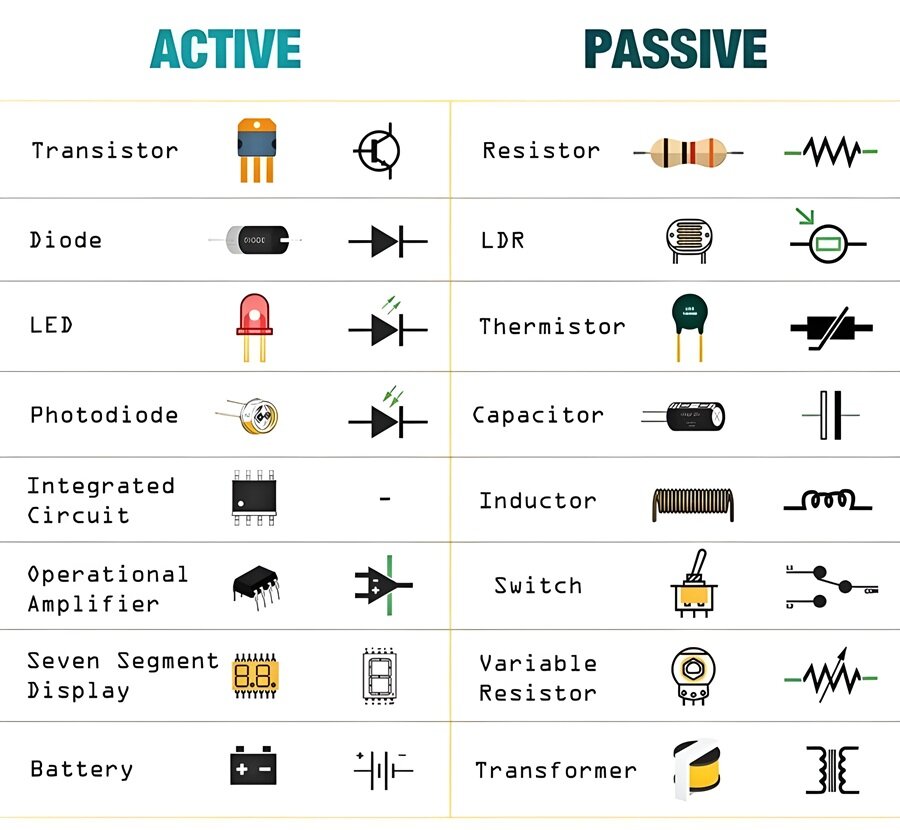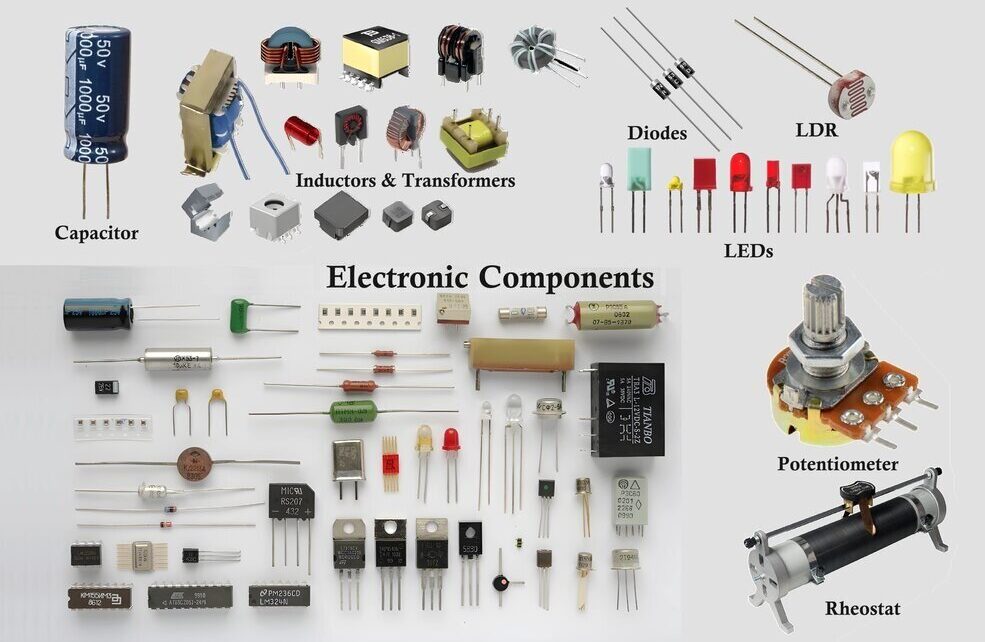Electronic components are the building blocks of electronic circuits and systems. There are various types of Electronic Components, each serving a unique function in the operation of electronic devices. They are broadly classified into two groups active components and passive components.
“Electronics components are any basic discrete device or physical entity present in an electronic system which affects electrons or their associated fields.” Electronic components are quite different from Electrical components do not be confused about them. Here are the basic electronic components,

Electrical components are mostly passive components/elements like wires/cables, resistors capacitors, inductors, etc. While Electronics components are active elements like transistors, BJTs, MOSFET’s, ICs, etc. Active components can amplify input signal but passive components can’t do that.
Electrical components mostly come in single quantities (like one capacitor or indicator) also they are big. Whereas Electronic components are small in size they come in IC package and contains a huge number of other small active and passive components to perform applications like amplification, rectification, pulse width modulation, etc.
Classification of Electronics components:
Here’s a comprehensive overview of the main types of electrical and electronic components:
1.) Active Electronics components:
Active components are those components which can control, manipulate amplify, or attenuate Electrical signals. They can add power to the circuit These components depend on a source (like a DC battery). Components like various types of diode transistor ICs etc. are included as inactive components.
Classification of Active Components:
Diodes
- Function: Diodes allow current to flow in one direction only, acting as rectifiers, signal modulators, and protection devices.
- Types: Standard diodes, Zener diodes, light-emitting diodes (LEDs), photodiodes, and Schottky diodes.
Transistors
- Function: Transistors act as switches or amplifiers in electronic circuits, controlling current flow.
- Types: Bipolar junction transistors (BJTs), field-effect transistors (FETs), and metal-oxide-semiconductor FETs (MOSFETs).
Integrated Circuits (ICs)
- Function: ICs are complete circuits on a single chip, containing multiple components like transistors, resistors, and capacitors.
- Types: Analog ICs (operational amplifiers, voltage regulators), digital ICs (microcontrollers, microprocessors, memory chips), and mixed-signal ICs.

2.) Passive Electronics component:
These components cannot add any power to the circuit. But in AC circuit components like a transformer (step up or step down) and resonance circuits (LC, RC, and LCR) can change current or voltage but they can’t change power of a signal. Also, they don’t depend on energy sources. They include two-terminal devices like a capacitor, inductor resistors, etc. They are also called reactive components.
Passive Components Group:
Resistors
- Function: Resistors limit the flow of electric current and divide voltages within a circuit.
- Types: Fixed resistors, variable resistors (potentiometers), thermistors, and light-dependent resistors (LDRs).
Capacitors
- Function: Capacitors store and release electrical energy, filter signals, and stabilize voltage and power flow.
- Types: Ceramic, electrolytic, tantalum, film, and supercapacitors.
Inductors
- Function: Inductors store energy in a magnetic field when electric current flows through them, filter signals, and block high-frequency noise.
- Types: Air core, iron core, and ferrite core inductors.
Transformers
- Function: Transformers transfer electrical energy between circuits through electromagnetic induction and can step up or step-down voltage levels.
- Types: Power transformers, audio transformers, and isolation transformers.
Active and Passive Components Difference:
Here you can see the major difference between active and passive components.

3.) Electromechanical components:
These are another type of electrical component that involves electrical as well as mechanical parts. The most common example are stepper motor AC motor relay switches, button, buzzer, etc.
Relays
- Function: Relays are switches that open and close circuits electromechanically or electronically.
- Types: Electromechanical relays, solid-state relays.
Switches
- Function: Switches make or break an electrical connection.
- Types: Toggle switches, push-button switches, rotary switches, DIP switches.
4.) Optoelectronic Components:
LEDs
- Function: LEDs emit light when an electric current passes through them, used for indicators and displays.
- Types: Standard LEDs, high-brightness LEDs, infrared LEDs.
Photodiodes
- Function: Photodiodes convert light into electrical current, used in sensors and communication devices.
- Types: Standard photodiodes, avalanche photodiodes.
Optocouplers
- Function: Optocouplers transfer electrical signals between two isolated circuits using light.
- Types: LED-phototransistor optocouplers, LED-photodiode optocouplers.
5.) Sensors and Detectors:
Temperature Sensors
- Function: Temperature sensors measure temperature and convert it into an electrical signal.
- Types: Thermocouples, RTDs (resistance temperature detectors), thermistors.
Light Sensors
- Function: Light sensors detect light levels and convert them into electrical signals.
- Types: Photoresistors (LDRs), photodiodes, phototransistors.
Motion Sensors
- Function: Motion sensors detect movement and convert it into an electrical signal.
- Types: Passive infrared sensors (PIR), ultrasonic sensors, microwave sensors.
6.) Power Sources:
Batteries
- Function: Batteries store and provide electrical energy.
- Types: Alkaline, lithium-ion, nickel-cadmium (NiCd), nickel-metal hydride (NiMH).
Power Supplies
- Function: Power supplies convert and regulate electrical energy for electronic devices.
- Types: Linear power supplies, switch-mode power supplies (SMPS).
Conclusion:
Understanding the different types of electronic components and their functions is crucial for designing, building, and troubleshooting electronic circuits. Each component type serves a specific role and can be used in various combinations to create complex electronic systems.
What are Active components in electronics and Their Classification


Thank U Very Much I Like It
Thanks
I need electronic components
Go to electronic components
nice